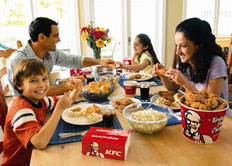A recent study on the opinions of quick-serve consumers finds that price ranks surprisingly low in determining where they choose to eat, that convenience is king, and that KFC draws more health-conscious consumers than the average brand.
Conducted by CFI Group, a consultancy based in Ann Arbor, Michigan, the study surveyed 1,200 consumers who had all eaten at a quick-service establishment in the past three days. The goal was to better understand how they made a basic decision: where to eat.
The study’s findings regarding specific brands hold few surprises. The glaring exception is that 17 percent of KFC customers listed healthy menu items as a determining factor in choosing the brand, which is best known for its fried chicken. This is higher than the 10 percent of the entire survey group who cited healthy menu choices as a determining factor.
KFC received much criticism from public-health activists earlier this year when it rolled out the Double Down, a breadless “sandwich” that features melted cheese, bacon, and sauce between two chicken filets (fried or grilled). Still, 7 percent of the KFC customers in the survey listed healthy menu options as the primary reason for choosing the restaurant.
The popularity among health-conscious quick-serve customers “floored” restaurant marketing analyst Joel Cohen. KFC has proactively sought to change its image in recent years—for example, by changing its official name from Kentucky Fried Chicken to KFC and by introducing grilled chicken items—but, Cohen says, “I’d be surprised if the results were that fast and dramatic.
“They are trying to change an image that has been drilled into our heads for a quarter century,” he says.
One explanation for the finding could be a general assumption among consumers that chicken is a healthier option than beef, says CFI’s Michael Drago.
While KFC fared well among the health-minded, Subway did the best by a long shot, with 62 percent of its customers citing healthy menu items as a determining factor—well above the 10 percent average.
2. Desired Type of Food
3. Low Prices
4. Taste
5. Speed
2. Desired Type of Food
3. Taste
4. Low Prices
5. Coupon
Having promoted itself as a fast and healthy alternative for more than a decade, first through its Jared campaign and now with its $5 Footlongs, Subway seems to have cornered the market in the quick-service sector. But the sandwich giant lagged behind when it came to taste, with only 12 percent of its customers listing it as one of the reasons they chose the brand. The survey average was 16 percent.
This could leave Subway “vulnerable” to competitors who manage to strike a better balance between health and taste, Drago says.
Of course, no quick-serve study is complete without a look at the industry leader. Of all 1,200 people in the survey group, 28 percent had most recently eaten at a McDonald’s—no surprise considering the predominance of convenience as a determining factor.
Corroborating McDonald’s image as a kid favorite, the study found that the company’s share of visits rose to 36 percent when there was a preteen involved in deciding where to eat. Furthermore, the preteen was the primary deciding party 32 percent of the time among McDonald’s customers, compared with the average of 15 percent.
“If children are involved,” Drago says, “they will demand McDonald’s.”
One more general finding that may surprise operators is that 49 percent of the survey group left their homes specifically to eat at a quick serve, and 78 percent of them knew exactly where they were headed. These were unexpectedly high figures, Drago says, because “destination dining” is associated more with full-service restaurants than the quick-service sector.
Of the remaining 51 percent who did not leave their house specifically to eat at a quick serve, 70 percent knew where they were going once they did decide to eat. All told, these figures suggest a high level of brand loyalty among quick-serve customers.
“The battle for business is being won,” Drago says, through effective marketing and consistency. “There are some folks who are still in play, but they are a smaller pool of the population than we expected.”
Among the reasons why consumers decided to eat at one restaurant over another, convenience ranked highest, with 48 percent of the survey population citing it as a determining factor. Food preference came in second at 37 percent, and price ranked last at 32 percent.
While these are not shocking findings—convenience has always had a strong influence on quick-serve customers—it is interesting that price ranked last in a down economy. The 32-percent figure represents those who listed price as a contributing factor among several others. Only 12 percent cited it as the primary reason they chose a certain restaurant.
“All things taken into consideration, convenience counts most of all,” Drago says. “And while price is important, when push comes to shove, taste wins out over price.”
CFI plans to release its full study on quick-serve consumer opinions in late November.








